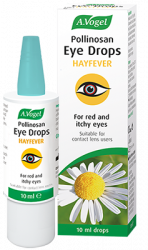An introduction to sneezing and hayfever
A sudden sneeze or bout of sneezing is often the first indication to sufferers that their hayfever is about to flare up. When you breathe in pollen, it irritates the lining of your nasal passages. Your body attempts to expel this irritant, and the reflex mechanism it employs to do this is a sneeze.
Why does hayfever make us sneeze?
When a foreign body enters your body, your immune system triggers a response to it. It either interprets it as potentially harmful and tries to fight it off, or allows it into your system.
For some people, their immune system regards pollen particles as potentially dangerous. The body produces more mucus to trap the particles, then triggers an irritation response to cause your body to expel the mucus and trapped pollen particles from your body.
When the nerve endings in your nasal cavities detect an irritant, a message is sent to the brain. Your facial nerves, and nerves in your diaphragm, neck and even eyelids are alerted. Your diaphragm contracts abruptly causing you to take a deep breath in, and then the muscles in your neck contract suddenly to allow this air to be released. Your eyelids also contract so that you close your eyes. The resulting expulsion is a reflex action known as a sneeze. Often it takes a few sneezes in a row before the irritant is cleared from your system.
Causes of sneezing
As all hayfever sufferers will be aware, pollen is one of the most common causes of sneezing, and this comes under the category of allergy induced sneezing. Other common causes are allergies to dust, animals and mould.
However, sneezes can also occur in response to less common or expected triggers, such as exposure to bright light. This is a reaction called a photic sneeze complex, and is a genetic condition affecting about a third of the population. Some people also begin to sneeze when their stomach is too full. It is called snatiation, or ‘sneezing non-controllably at a time of indulgence of the appetite – a trait inherited and ordained to be named.’
Fun facts about sneezing
- Sneezes travel at about 100 mph. That’s quite a forceful expulsion of pollen and a single sneeze can send about 100,000 germs into the air!
- We can’t sneeze while we are asleep because all the muscles and receptors which work together to create a sneeze are all asleep too. Maybe the answer for hayfever sufferers is to stay asleep!
- We can’t sneeze with our eyes open. Maybe it is just as well, otherwise our eyes would get a full blown impact of germs we have just expelled. However, the old myth that our eyes will pop out if we sneeze with our eyes open is not true
- Mucus expelled by a sneeze can land five feet away or more
- Sternuation is the medical term for sneezing
- If you want to stop a sneeze before it comes you can try pinching the tip of your nose, tickling the roof of your mouth, or pressing hard on your upper lip. However, you should not try to stop a sneeze mid-sneeze, as this can put high pressure on blood vessels in your eyes and ears.




 Looking for relief of red and itchy eyes due to hayfever?
Looking for relief of red and itchy eyes due to hayfever?

